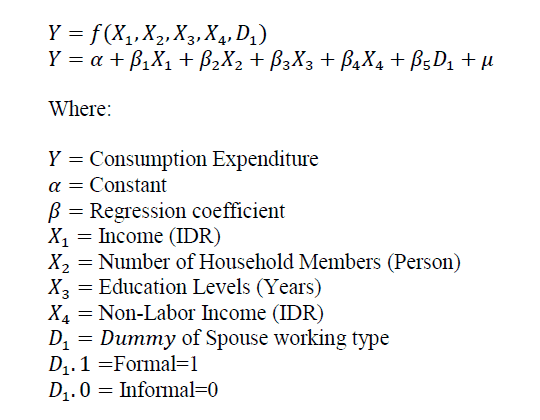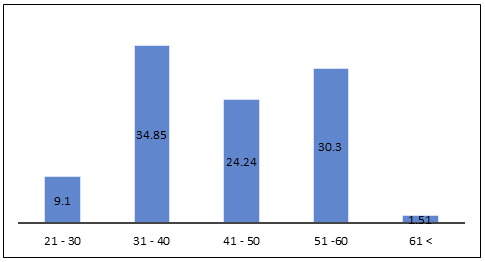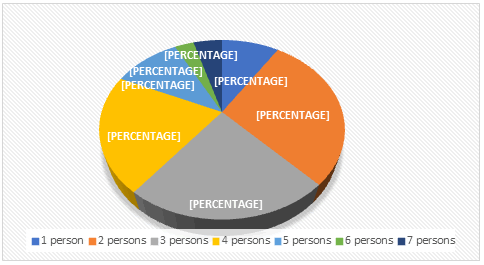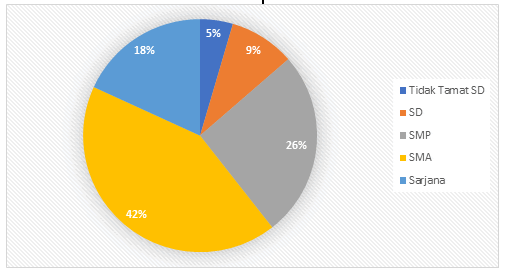Research Article: 2021 Vol: 20 Issue: 2S
The Determinants of Consumption Expenditure of Female Worker in Informal Sector in Makassar
Fatmawati, Hasanuddin University
Retno Fitrianti, Hasanuddin University
Baso Siswadharma, Hasanuddin University
Keywords
Household Consumption, Patterns, Female, Workers, Informal, Sector
Abstract
This study aims to determine Makassar’s household consumption pattern of female workers in informal sector. Do income, number of family members, non-labor income, spouse’s working type influence the pattern of consumption expenditure of female workers in informal sector. How much income contribution of female workers in informal sector in Makassar? Primary data is used in this study. It is obtained from survey method with 100 female respondents who work in informal sector in Makassar. This study found that consumption pattern is dominated by 73% of non-food and 23% of food expenditure. The determinant of household consumption pattern of female workers is determined by income, number of family dependents, and non-labor income, but not for education level. There is no difference between spouse’s working type in formal and informal sectors which can affect the household consumption pattern of female workers in informal sector.
Introduction
Consumption is important part to analyze long run and short run economy. Consumption is daily interaction, everybody is always connected to fulfill their needs such as food, health, education, entertainment, and other needs. Consumption expenditure is a cycle from the beginning to the end of life, it means that everybody surely does consumption activity. There are number of goods and services are offered to society to be consumed in order to fulfill their needs. The amount of consumption can be placed as a measurement of household’s welfare. Every household has a different consumption behavior, like as what to be consumed, how to be consumed, tasted, flavor, and etc.
Higher income household will consume more rather than the lower income (Pracoyo, 2005). Consumption pattern really depend on household income, the higher the income the higher their needs to be fulfilled. Basically, consumers have a bundle of choices and combination of goods to maximize their utility. (Arida, Sofyan & Fadhiela, 2015; Sari, Syahnur & Seftarita, 2017; Hussain, Hassan, Rafiq & Quddus, 2019). Proportion of consumption pattern is used to determine household consumption.
The role of consumption is not only to measure household family but also externally as benchmark of economy development and state’s welfare, because every single family do different consumption expenditure path. Consumption path can be used to see the effects of consumption on family’s welfare. In this case, the role of woman is very essential to manage household finance. Household with medium-up income do not face any constraint to satisfy their needs. However different case happened to lower income households, especially to workers in informal sector with uncertain income, they will face many obstacles to fulfill their needs.
Women who involved as worker will influence household working pattern (Espinal & Grasmuck, 1997). Women involvement in working world is an evidence of providing equality the development. Nevertheless, there is still discrimination on it. Government promotes and supports women’s entrepreneurships. By doing so it will increase women opportunity in the market as a key to lift up the women’s level, their family, and escape from the poverty. These conditions will fix the environment of gender’s entrepreneurship (Boeri, 2018). Informal sector is very important to increase welfare of lower income society, thus this sector can be used as a source of income and maximizing benefit by working in informal sector (Neves & Du Toit, 2012) and in turn will help poverty alleviation in rural area (Muhammad Arsyad et al., 2020).
Formal and informal activities are identified by employment status. Component of working society in informal sector is consist of working with their own business, working by getting help from temporary labor/unpaid labor, free workers in agriculture, free workers in non-agriculture, and family workers/unpaid workers. Based on Survei Angkatan Kerja Nasional (Sakernas) in February 2020 (BPS, 2020b), 63% or around 6 from 10 female workers are working in informal sector. They are more dominating in some sectors, such as agriculture, forestry, trade, and processing industry (Kompas, 2020), including seaweed industry for earning foreign exchange income (Yusuf, Arsyad & Nuddin, 2018) in the economy.
The informal workers in South Sulawesi Province in February 2019 is about 62.54%, and the rest 37.46% is formal workers (BPS, 2019). The number of female informal workers in Makassar City, 2019, is around 79.511 persons or around 34.55% (BPS, 2020a). These data show that the number of female workers in informal sector in Makassar is still high relatively.
Recently the motivation of female workers is more complex, but the main reason is to solve the family’s financial problem. Income contribution is a share from female workers to their family which indicated by amount of income received and amount of income given to the household (Pratomo, 2017). In addition to that family’s economy describe the whole need of family like as food, education, health, and services. In order to fulfill their needs, women are motivated to work and one of the choices is informal sector. By doing so they can obtain additional income and also take care of their family.
The condition of female worker in informal sector is a profession which always related to the issues of welfare improvement (Farida, 2011). It shows that household or workers in this profession tend to have a lower income to fulfill their needs. This vulnerability happened because their spouses are unemployed and have the lower education’s level (Khan & Khan, 2019). This research aims to analyze female workers consumption expenditure in informal sector in Makassar area (BRIS, 2019)
Consumption pattern is the number of percentages of income distribution to each expenditure such as foods, clothes, services, recreation, and entertainment. To be specific, consumption expenditure is all expenses for foods, beverages, party or ceremony, old stuffed, and others. It has been done by every family member inside and outside the house, and also for private and family needs (BPS, 2020a). Household consumption expenditure involves various household final consumption of goods and services to fulfill individual or group needs directly. Ernest Engel states that the percentage of food expenditure is going down in line with increasing in income (Baffes & Etienne, 2014). Therefore, household expenditure composition can become an indicator to welfare. The lower the percentage of food expenditure to the total expenditure, the higher the economy welfare.
There are three essential characteristics of household consumption in absolutely income in Keynesian Theory. First, the level of household consumption in one period is determined by disposable income that has been received in certain period. There is positive correlation between consumption and disposable income, the higher the disposable income the higher the household consumption. Second, if the disposable income is increase, then the consumption will increase but in diminishing term of income. Third, although someone or family does not have income, they still consume by the existence of autonomous consumption.
Consumption pattern of society describe the propensity to consume through foods and non-foods. This consumption tendency is influenced by some factors, such as income, tastes, price of goods, education level, number of family, and environment. Income become very important factor to determine household expenditure, including family foods consumption pattern. If the income increase, the consumption pattern will be various so that food consumption with high nutritional value will increase (Arida et al., 2015; Hussain, Rafiq, Quddus, Ahmad & Pham, 2021)
Khan & Khan (2019) examined the determinant factor of female workers in informal sector which contributed to household income. It used OLS model with 973 observations. The result shows that female as a household leader, education, asset ownership have a positive effect on their contribution. Large family burden, poverty, and loan that has to be borne by the women workers in informal sector has a negative effect on their contribution. This will help poverty alleviation and reducing resource conflict in social-economic development (Arsyad et al., 2020).
Sultana & Kiani (2011) tested the determinant of household consumption in Pakistan by using Logistic Regression. This result show that living place (urban area) negative significantly influenced household foods vulnerability status. The independence ratio has significantly impact on foods vulnerability and has a negative sign. The education of household leader is also positive significantly influenced it. Therefore, based on these all description and phenomenon, this study aims to determine consumption pattern of female workers in informal sector. It will explore the determinant which influenced the pattern, such as number of family members, non-labor income, and spouse’s working type. In addition, it also tries to measure the income contribution of female workers.
Methodology
This research was conducted in Makassar City by using primary data of 100 samples of female workers in informal sectors. It spread in 15 sub-districts in Makassar. Makassar was chosen as the research location because based on data, the largest population and number of female workers in South Sulawesi were in Makassar. It used survey method by applying questionnaire to obtain information related to consumption expenditure path of female worker of informal sector in Makassar. This research used multivariate linear regression to measure the elasticity of the determinant of consumption expenditure. The independent variable consists of income, number of family members, education, non-labor income, spouse working type. To estimate the parameter in this multivariate linear regression, this research used Ordinary least Squared method. The equation model as followed:

Results and Discussion
Female Worker Characteristics
There are 39% of 100 respondents in productive age (31years- 40 years), 28% 41-50 years old, and 24% in 51 – 60 years old. This indicated that female who work in informal sectors is in the productive age and can be contributed economically to increase income. (Figure 1)
Respondent distribution based on number of dependents is 27% respondent with 3 number of dependents; 25% with 2 number of dependents; and 18% respondent with 4 number of dependents. (Figure 2)
The respondent who lives in urban area has few dependents and based on their core family. Based on the respondent the more having kids will increase their living cost especially for education and health, while they lack to complete their needs and other cost. (Figure 3)
The education level is formal education that has been completed by the respondent. Data show that 39% respondent is in the senior high school; 25% in junior high school; and 12% is bachelor. The awareness about the important of education is very big because the IPM of Makassar show increasing trend. This data in line with literate rate in 2019 is around 99.3% (BPS, 2020a).
Generally speaking, it can describe that the object of this research is female workers that have been married and in productive age. Thus, this status shows that they are willing to work at home to help their husband to fulfill their family needs and if the female is widow then they act as the backbone of the family and has family dependent. The work coverage is trading, selling something online, and serving such as tailors, household assistant, daily laundry workers, boarding houses, and private tutors.
Beyond the main job, there is also a side job. There are 18% respondent has a side job in plastic recycling, pharmacist, sewing pot mats, owning an online shop, and Posyandu members. This side job is done around 2 hours per day or 3 days per week which is not routinely. Income from this side job is increasing enough the main income, around 20% - 50% from the main side income. It has been done, if they have free time which is not disturb mainly routine works.
Based on theory and empirical works, determinants of consumption expenditure of informal sector in Makassar city are determined by income, number of dependents, education level, non-labor income, age and type of spouse’s working or husband occupation. The estimation result shown in Table 1.
| Table 1 Estimation Result Determinants of Consumption Expenditure of Female Worker in Informal Sector |
||||
|---|---|---|---|---|
| Variable | Coefficient | Std. Error | t-Statistics | Prob |
| Ln X1 | 1.092861 | 0.10056 | 1.923445 | 0.0503 |
| Ln X2 | 1.309962 | 0.132178 | 2.345036 | 0.0213 |
| Ln X3 | 0.342824 | 0.232175 | 1.476574 | 0.1434 |
| Ln X4 | 1.052333 | 0.089764 | 2.197047 | 0.0326 |
| D1 | 0.007917 | 0.172778 | 0.045819 | 0.9636 |
| C | 10.52169 | 1.393472 | 7.550701 | 0 |
| R-Squared | 0.512171 | |||
| Durbin-Watson Stat | 1.745043 | |||
| F-Statistic | 4.686015 | |||
| Prob (F-Statistic) | 0.000777 | |||
The estimation result show that not all independent variable influenced the consumption expenditure of female workers in informal sector. Regression coefficient of Ln X_1 is 1.09, it means that if income increased by 1%, the consumption expenditure will increase by 1.09%. Statistically, this variable has positive and significant impact on consumption expenditure of female worker in informal sector. This result in line with Engel Law which mentioned that household with lower income will expense most of their income for their basic needs. Income has positif significanly effect on consumption (Farida, 2011; Fitrianda, 2013; Sultana & Kiani, 2011; Yimer, 2011; Zani, Saediman, Abdullah, Daud & Yunus, 2019). Most of them work in trading sector, then obtain daily profit from this activity. It is different from female worker in formal sector who received monthly salary. This monthly salary can be managed to fulfill their all needs in a month (Hussain, Rafiq, Quddus, Ahmad & Pham, 2021). Nevertheless, the unmanaged income such as daily income, make female workers very careful to fulfill their needs.
The number of family dependent has a positive and significant sign to consumption expenditure of female worker in informal sector. The regression coefficient of number of dependents is 1.04%. It means that if number of dependent increased by 1%, consumption expenditure will increase by 1.04%. The greater number of family dependent, the higher the consumption expenditure and its variant, because every member has different tastes, needs and income determination. This findings in line with Dianawati & Mustika, (2016); Wuryandari (2015), Yimer (2011); Nurhapsa, et al., (2020) and environmental health awareness (Unde, Arianto, Bahfiarti, Pulubuhu & Arsyad, 2020). The greater number of family dependent, the higher the consumption expenditure either foods or non-foods. Therefore, female worker in informal sector has a few numbers of children, because they realize that consumption and education cost is high enough, while their income is still uncertain. Generally, the spouses of female workers are also working in informal sector and some of respondent jointly manage their business for enterprises integration (Darma, Fudjaja & Tenriawaru, 2018) and farmers income (Salam et al., 2019) to formulate development strategy (Nadja et al., 2019) and avoid vulnerability situation (Syam, Salman, Hasan & Sirajuddin, 2019).
In the other side, education level shows that there is no effect on consumption expenditure of female worker in informal sector. It is in line with the finding of Dianawati & Mustika (2016). The highest education of respondent is bachelor, and the lowest level of education is not completing elementary school. The biggest distribution of respondent, 39%, is completing senior high school and 25% completing junior high school. The education of female worker in informal sector is relatively low. Although their education level is mostly senior high school, but under uncertain income they are very careful to manage it. They always think to save small amount of their income to anticipate uncertain condition such as sick and school holiday. In school holiday their income tends to decrease.
Non labor income is non income from the main job. It is obtained out of the main job such as spouse income and other family member incomes. The existence of non-labor income will increase income as a whole then also increase the household consumption expenditure. The estimation result show that non labor income has positive and significantly influence the consumption expenditure of female worker in informal sector in Makassar. By 95% confidence level, the coefficient regression is 1.05%. It means that if non-labor income increased by 1%, the consumption expenditure increased by 1.05%. This finding is in line with Rosiana & Saskara (2018); Tigau, Rotinsulu & Wauran (2017).
Furthermore, the estimation result is spouse working type. This result show that there is no difference between spouse who work either in informal or formal sector. The estimation show that dummy coefficient is not significant. Thus, we can conclude that there is no difference between spouse in formal and informal sector to consumption expenditure of female worker in informal sector. It can be happened because most husband/spouse are working in informal sector, i.e. construction labor, driver, and joint business with her wife.
Simultaneously, income, number of dependents, education level, and non-labor income influenced significantly household consumption expenditure of female worker in informal sector. It can be shown in F-test significantly as much as 4.686 with α=5%. Determination coefficient as much as 0.512. It means that variation of consumption pattern 51.21% is determined by income, number of household dependents, education level, non-labor income and spouse or other family members working type. The rest of 48.79% is determined by the variables out of model. This is in line with Dianawati & Mustika (2016); Rosiana & Saskara (2018); Yimer (2011).
Conclusion
Income, number of dependent family, and non-labor income significantly influenced the consumption expenditure of female worker in informal sector in Makassar. Education level do not influence to the household consumption expenditure. This research also shows that there is no difference between spouse/husband either working in informal or formal sector to consumption expenditure of female worker in informal sector. Simultaneously, based on statistically test, there is an effect on income, number of dependent family, education level, and non-labor income of consumption expenditure of female worker in Makassar.
References
- Arida, A., Sofyan., & Fadhiela, K. (2015). Household Food Security Analysis Based on Proportion of Food Expenditure and Energy Consumption. Agrisep, 16(1), 20–34.
- Arsyad, M., Nuddin, A., Fahmid, I.M., Salman, D., Pulubuhu, D.A.T., Unde, A.A., & Djufry, F. (2020). Agricultural development: Poverty, conflict and strategic programs in country border. In IOP Conference Series: Earth and Environmental Science, IOP Publishing, 575, 12091).
- Arsyad, M., Pulubuhu, D.A.T., Kawamura, Y., Maria, I.L., Dirpan, A., Unde, A.A., …& Yusuf, S. (2020). The role of public health services (PHS) in agricultural poverty alleviation. Enfermería Clínica, 30, 194–197.
- Baffes, J., & Etienne, X.L. (2014). Reconciling high food prices with engel and prebisch-singer. International Conference on Food Price Volatility: Causes and Consequences, 1–34.
- Boeri, N. (2018). Challenging the gendered entrepreneurial subject: Gender, development, and the informal economy in India. Gender & Society, 2(3).
- BPS. (2019). Survei Angkatan Kerja Nasional Februari 2019.
- BPS. (2020a). Kota Makassar Dalam Angka Tahun 2020.
- BPS. (2020b). Survei Angkatan Kerja Nasional Februari 2020.
- BRIS. (2019). Keadaan Ketenagakerjaan Sulawesi Selatan.
- Darma, R., Fudjaja, L., & Tenriawaru, A.N. (2018). Fishery based-processing enterprises integration for the coastal community development. JEAS, 13(3), 588–595.
- Dianawati, W., & Mustika, M.D.S. (2016). CANANG IN THE TRADITIONAL MARKET OF DENPASAR BARAT DISTRICT Faculty of Economics and Business, Udayana University (Unud), Bali, Indonesia.
- ABSTRACT INTRODUCTION Bali is one of the small islands in Indonesia which is known as the island of Serib. E-Journal of EP Udayana University, 5(5), 530–556.
- Espinal, R., & Grasmuck, S. (1997). Gender, Households and informal entrepreneurship in the dominican republic. Journal of Comparative Family Study, 28(103–128).
- Farida, L. (2011). Informal on family economy in pekanbaru city. Journal of Business Applications, 1(2), 103–112.
- Fitrianda, M.I. (2013). Factors that influence the consumption expenditure of poor families in Kalipuro District, Banyuwangi Regency. Jember.
- Hussain, S., Hassan, A.A.B.G., Rafiq, M., & Quddus, A. (2019). The impact of exchange rate exposure and working capital on return on equity. International Journal of Disaster Recovery and Business Continuity.
- Hussain, S., Rafiq, M., Quddus, A., Ahmad, N., & Pham, T.P. (2021). Pak rupee as a currency and currency war. Journal of Contemporary Issues in Business and Government, 27(1), 88-95.
- Hussain, S., Rafiq, M., Quddus, A., Ahmad, N., & Pham, P.T. (2021). China-Pakistan economic corridor: Cooperate investment development and economic modernization encouragement. Journal of Contemporary Issues in Business and Government.
- Khan, T., & Khan, R.E.A. (2019). Urban informal sector: How much women are struggling for family survival. The Pakistan Development Review, 48(1), 67–95.
- Kompas. (2020). Ministry of Manpower: 6 out of 10 female workers work in the informal sector. Compas.Com.
- Nadja, R.A., Langkong, J., Amrullah, A., Arsyad, M., Jamil, M.H., Viantika, N.M., …& Ginting, N.M. (2019). Development strategy of passion fruit agro-industry: Evidence from South Sulawesi, Indonesia. In IOP Conference Series: Earth and Environmental Science, IOP Publishing, 343, 12107..
- Neves, D., & Du Toit, A. (2012). Money and sociality in South Africa’s informal economy. Africa, 82(1), 131–149.
- Nurhapsa, N., Nuddin, A., Suherman, S., Sirajuddin, S.N., Al-Tawaha, A.M., & Al-Tawaha, A.R.M. (2020). Factors affecting coffee use income: A case study in the province of south Sulawesi, Indonesia. Ecology, Environment and Conservation, 26, S263–S270.
- Pracoyo, A. (2005). Aspek Dasar Ekonomi Makro Di Indonesia. Grasindo.
- Pratomo, D.S. (2017). Education and women's labor force participation in indonesia: Analysis of the U-Curve hypothesis. Journal of Applied Quantitative Economics, 1–8.
- Rosiana, W., & Saskara, I.A.N. (2018). Factors affecting household expenditures of female workers who work in the household laundry industry in south denpasar district. E-Journal of Economics and Business, Udayana University, 11, 2357.
- Salam, M., Sari, A.N., Bakri, R., Arsyad, M., Saadah, Jamil, M.H., …& Muslim, A.I. (2019). Determinant factors affecting farmers’ income of rice farming in Indonesia. In IOP Conference Series: Earth and Environmental Science.
- Sari, H., Syahnur, S., & Seftarita, C. (2017). Factors affecting consumption expenditures. Darussalam Economic Perspectives Journal, 3,117–133.
- Sultana, A., & Kiani, A. (2011). Determinants of food security at household level in Pakistan. African Journal of Business Management, 5(34), 12972–12979.
- Syam, J., Salman, D., Hasan, S., & Sirajuddin, S.N. (2019). Adaptive strategies of livestock waste processing technology to vulnerability availability of animal feed. In IOP Conference Series: Earth and Environmental Science, 235, 12094.
- Tigau, R., Rotinsulu, D.C., & Wauran, P.C. (2017). Informal sector in bukit kasih, kanonang dua village income analysis and consumption pattern informal sector, 17(01), 124–133.
- Unde, A., Arianto, Bahfiarti, T., Pulubuhu, D.A.T., & Arsyad, M. (2020). Strategy on family communication and the extent of environmental health awareness in coastal area. Enfermería Clínica, 30, 64–68.
- Wuryandari, R.D. (2015). Factors affecting indonesia's food, education and household health expenditures (2011 Susenas Data Analysis). Journal of Indonesian Population, 10(1), 27.
- Yimer, S. (2011). Determinants of food consumption. Journal of the American Dietetic Association, 90(5), 661–663.
- Yusuf, S., Arsyad, M., & Nuddin, A. (2018). Prospect of seaweed developement in South Sulawesi through a mapping study approach. In IOP Conference Series: Earth and Environmental Science, 157.
- Zani, M., Saediman, H., Abdullah, S., Daud, L., & Yunus, L. (2019). Determinants of household food expenditure in a cassava growing village in southeast Sulawesi. Academic Journal of Interdisciplinary Studies, 8(3), 302–310.


